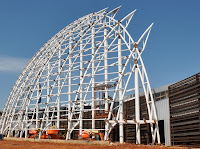American Indians believe in the native world view that everything is related to all other things. The environment is a sustainable life force that can maintain itself over many generations. North America’s #1 recycled material, steel, believes in a similar sustainability and will be used to build Oklahoma City’s American Indian Cultural Center and Museum (AICCM).
While only two American Indian tribes are indigenous to Oklahoma, as many as 39 were forced to move to the area over the nation’s history. Despite their homelands being from all corners of the United States, their cultures are still alive and vibrant today.
Nathan Hart, AICCM’s Director of Community Affairs, emphasized the above  sentiment and has been involved in the planning and construction of the 141,000+ square foot facility since 2002. Since the facility began preparations, the environment has played an essential role.
sentiment and has been involved in the planning and construction of the 141,000+ square foot facility since 2002. Since the facility began preparations, the environment has played an essential role.
“Environmental considerations were driven a lot by the individuals involved,” explained Hart. “The native world view that everything is related to all things, the environment, universe, plants, animals, that view gave guidance to the design team to make efficiencies in design.”
The efficiency of steel was an easy selection for the design team.
“It was the best material available with the strength and flexibility we wanted. The ‘Hall of the People’, the whole building itself, is at a curve. You can run straight beams in an area and hide them but in the ‘Hall of the People’ it is a big open structure, high arc tresses and steel was the only way we could accomplish that. We wanted nice high curvature.”
Hart also stated that steel’s ultimate recyclability was a bonus in selecting it and they are very fortunate to have W&W Steel within a mile of the facility for any excess steel from the property to be recycled.
As of now they are estimating around 1636 tons of steel to be used during phase one of their construction process. More will be used as additional areas of the 250 acres are constructed.
When all is completed, estimated in 2014, the area located on the Oklahoma River will be home of the cultural center, museum, athletic fields, shopping plazas and art galleries. Many of the buildings using steel as the primary material.
“The American Indian cultures themselves are very resilient,” said Hart. “And with the construction and materials we use, such as steel, the buildings reflect that resiliency as well.”


